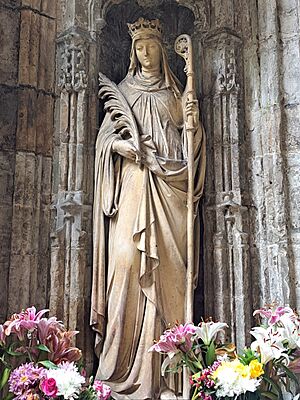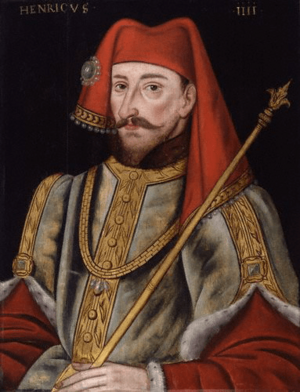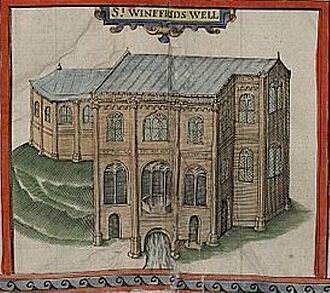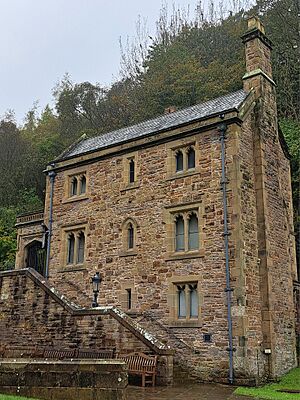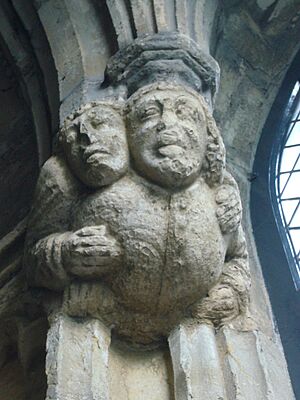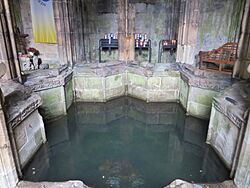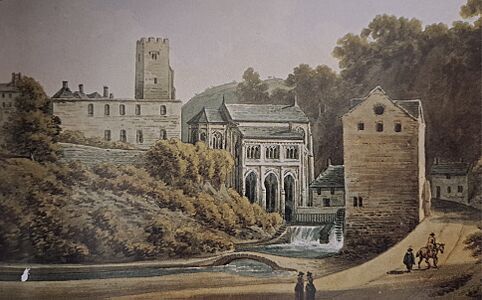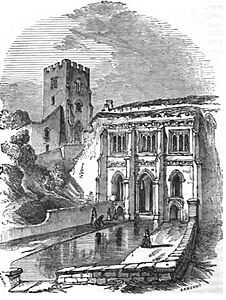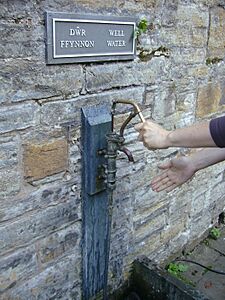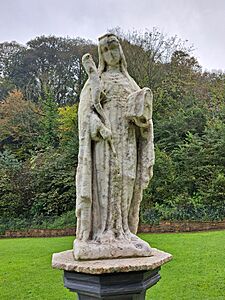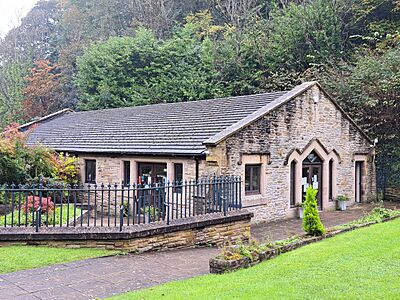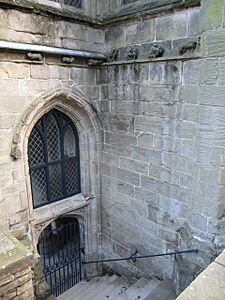St Winefride's Well facts for kids
Quick facts for kids St Winefride's Well |
|
|---|---|
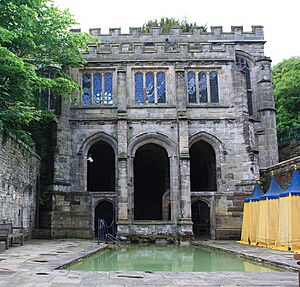 |
|
| Religion | |
| Affiliation | Roman Catholicism |
| Patron | Saint Winefride |
| Status | Active |
| Location | |
| Location | Holywell, Flintshire |
| Country | Wales |
| Architecture | |
| Architectural style | Perpendicular Gothic |
| Completed | c. 1512–1525 |
| Materials | Sandstone |
St Winefride's Well (in Welsh, Ffynnon Wenffrewi) is a special holy well and a national shrine in the town of Holywell, Flintshire, Wales. It's named after St Winefride, a Catholic saint from the 7th century. Legend says she was brought back to life after a prince attacked her. The well is believed to have appeared where her head touched the ground. This story has made St Winefride's Well a popular place for pilgrimage for hundreds of years. People visit because they believe its waters can heal. It's special because it has been a place of pilgrimage continuously, even during the English Reformation when many other holy sites were closed.
During the Middle Ages, the well was part of Basingwerk Abbey. Many English kings, like Richard II and Henry IV, visited it. When the Church of England was created, people tried to stop Catholic pilgrimages to the well. But they didn't succeed. From the 1700s, more tourists came, believing the water had natural healing powers from its minerals. Two bath-houses were built there in 1869. In 1917, the well dried up because of mining nearby. To make it flow again, water had to be brought from a new underground source.
The chapel built over the well is from the 1500s. It's a very important historic building. It has two parts: an upper chapel and a well crypt below. The upper chapel has been used for different things, like a court and a school. Today, it's used for religious services. The well crypt has a star-shaped pool around the spring and a statue of St Winefride from the 1700s. Both parts of the chapel are looked after by Cadw, a Welsh heritage organization.
Today, the well is open to visitors. You can bathe in the water at certain times or fill bottles from an outdoor tap. There's also a visitors' centre and a museum. Groups of pilgrims visit several times a year. During the pilgrimage season, a special item linked to St Winefride is shown daily in the well crypt.
Contents
Who was St Winefride?
The story of St Winefride, the saint the well is named after, comes from two old books written in the 1100s. Both books tell a similar story about how the well began.
Winefride was the daughter of a local leader named Teuyth. She was taught by St Beuno and decided to dedicate her life to God. One Sunday, a prince named Caradoc visited her home. He tried to force her to be with him. Winefride pretended to agree, but asked to go to her room first to change. This was a trick so she could escape and run towards Beuno's church.
Caradoc caught up to her as she reached the church. He cut off her head with his sword. Her body fell outside the church, but her head landed inside. Right where her head landed, a spring of water burst from the ground.
Beuno then cursed Caradoc, who died instantly. Beuno put Winefride's head back on her body and prayed for her to come back to life. His prayer was answered! Winefride lived again, with only a thin white line around her neck as a sign of her injury. The old stories say she later became the leader of an abbey in Gwytherin, where she eventually died.
A Look at the Well's History
How Old is the Well?
We don't know exactly how long St Winefride's Well has been famous. A piece of an old wooden box from the 700s shows that Winefride was already seen as a saint. The first time the town of Holywell is mentioned by name is in a document from 1093. This document talks about "the churche of Haliwel." It seems St Winefride wasn't very well-known at this time. A historian named Giraldus Cambrensis visited the area in 1188 but didn't mention her or the well.
In 1135, Holywell and its church were given to the new Basingwerk Abbey. As the Middle Ages continued, St Winefride's fame grew. Many people came to Holywell to pray and use the water, which they believed had healing powers.
Royal Visitors and New Chapels
Several English kings visited the well. The first known royal visit was by Richard II in 1398. Richard even hired a priest to say regular prayers at the well. This tradition was continued by kings for many years.
Henry IV visited the well in 1403 after winning a battle. He might have been thanking St Winefride for saving his son, who was hurt in the battle. Or, his visit might have been for political reasons, to show people that the saint supported him. Henry seems to have built the first chapel over the well.
Another king, Edward IV, also visited the well around 1461. Like Henry, he might have wanted to show that St Winefride supported his rule.
The chapel built by Henry IV didn't last long. The chapel you see today is thought to have been built around 1512-1525. Money for it was likely provided by Abbot Thomas Pennant of Basingwerk Abbey.
The Well During the Reformation
In 1534, Henry VIII broke away from the Pope and started the Church of England. This changed religion in England a lot. Catholicism was made illegal, and old traditions like pilgrimages were seen as wrong. But even with these changes, St Winefride's Well continued to attract many Catholic pilgrims throughout the 1500s and 1600s. This makes it special among Britain's holy sites.
Basingwerk Abbey was closed around 1537. The well then became property of the Crown. The authorities tried to control the well, but local Catholics kept bringing their own donation boxes. This helped protect the chapel from being destroyed.
During the reign of Elizabeth I, laws against Catholics became stricter. Large gatherings of Catholics were seen as a threat. But the well remained popular. In 1579, Elizabeth ordered the water to be tested to see if it had natural healing powers. If it did, only sick people could visit. If not, the chapel was to be torn down. We don't know what happened, but the chapel stayed standing, and pilgrimages continued.
The 1600s: Challenges and Changes
In 1605, a Jesuit priest named Henry Garnet led a pilgrimage to St Winefride's Well. He was later accused of using the trip to plan a conspiracy, but historians don't think this is true. After this, laws against Catholics became even harsher.
In 1617, a bishop tried to stop Catholics from visiting the well by making them take an oath. But this didn't last. A few years later, a Catholic report said that when the Bishop of Bangor tried to arrest priests and Catholics at the well, local people, even Protestants, stood up to him and threw him in a ditch!
In 1626, a judge named John Bridgeman tried to stop pilgrimages. He ordered inns to report their guests and made Catholics take an oath. He thought he had stopped the pilgrimages. But in 1629, a huge crowd of 1,400 people, including many priests, gathered at the well for St Winefride's feast day.
Bridgeman tried even harder in 1637. He closed most of the inns, damaged the statue of Winefride, and removed supports for bathers. He even suggested building a wall to block the well. The chapel was also damaged during the English Civil War.
Not all Protestants thought healing wells were supernatural. Many believed the cures came from the water's natural minerals, like at a spa. Many Protestants visited St Winefride's Well for its health benefits.
When the Catholic king James II came to power in 1685, it was a short break for pilgrims. James visited the well in 1687 to pray for a son. He also gave money to fix the upper chapel. But James was removed from power the next year, and England became Protestant again.
From the 1700s to Today
In the 1700s, St Winefride's Well became popular with tourists as well as pilgrims. Travel was easier, and stories about the well spread. It became a must-see stop for travelers like Daniel Defoe and Samuel Johnson. People started to think the cures were from the water's chemicals, not from the saint. In 1722, the upper chapel became a school. By 1795, fewer Catholic pilgrims were visiting.
But this changed in 1805. A young woman named Winefrid White, who couldn't walk without a crutch, bathed in the well and was immediately cured. This amazing story was widely shared. A bishop said it was a "miracle." This event, along with a new interest in medieval history, brought pilgrims back to Holywell. The upper chapel was used for religious services again from 1841.
In 1859, it was found that the chapel's foundations were weak. The water was moved for a few days while workers fixed the well pool. In 1869, two new buildings were started: the Well House, a bath-house and caretaker's home, and the Westminster Bath, a swimming pool. These were finished by 1871. A fee was charged to enter the well complex. In 1886, a statue of St Winefride was placed at the entrance.
On January 5, 1917, St Winefride's Well dried up. This was because of a mining tunnel nearby. After a search, a new underground water source was found and piped into the well. The well started flowing again on September 22, and people believed the water still had its healing powers.
In 1930, part of the stream from the well was covered, and an old brewery next to it was torn down. The area was turned into a garden called St Winefride's Park. In the 1990s, the Well House became a museum and library, and the Westminster Bath became a visitors' centre. In 2010, Cadw took over looking after the well crypt. They did restoration work to fix the masonry and repair damage.
In November 2023, the site was officially named a national shrine.
Stories of Miracles
Many miracles have been linked to the well, from the 1100s to today. The earliest stories tell of amazing cures and punishments for those who disrespected the site. Lists of supposed miracles were made in the 1600s, 1700s, 1800s, and 1900s. Until the 1960s, crutches and special boots left by pilgrims were displayed around the well. Some of these crutches are now in the visitors' centre.
How People Use the Well Today
St Winefride's Well is still a popular place for pilgrims. Its long history of healing has given Holywell the nickname "the Lourdes of Wales." The traditional way to bathe is to pass through a small pool three times while saying a prayer. Then, you move to an outer pool and kneel on a stone called St Beuno's stone, praying until you finish. Visitors in the 1700s also reported ducking their heads under the water to kiss St Beuno's stone and make a wish.
Today, the well is open to the public, but bathing is only allowed at certain times. You can get filtered well-water from a tap. People have always believed the water keeps its special power even when taken away from the site. The museum at the well has a piece of the True Cross and other saintly items, including a piece of bone believed to be from St Winefride.
Organized group pilgrimages happen several times a year. The most popular is in June, with a procession from St Winefride's Church to the well. There's a Mass in the well garden and a special showing of Winefride's relic. During the pilgrimage season (from Pentecost to late September), there's a daily service in the well crypt. An annual Orthodox pilgrimage has also taken place every October since 1987.
Natural Features of the Well
The spring that feeds St Winefride's Well used to be much stronger. In the Middle Ages, people said anything dropped into the well would be carried away quickly. A poet in 1652 described the well as "continually work[ing] and bubbl[ing] with extreme violence, like a boiling cauldron." In 1731, visitors measured how fast the basin filled and thought the spring produced "more than one hundred tons of water in a minute." Even today, the spring is known for its large amount of water. Stones have been placed over where the water comes out to stop it from becoming a fountain.
In the past, the stream bed had red stones. Legend said they were stained with Winefride's blood. The red color was probably from natural iron in the water or a red algae that still grows on the north wall today. The well was also known for its moss, which smelled sweet and was called "St Winefride's hair." Pilgrims often took these stones and moss as good luck charms.
The Chapel's Architecture
The well chapel is a very important historic building, protected since 1951. It has two parts: the upper chapel for church services and the well crypt below, which surrounds the spring. The building is in the Perpendicular Gothic style, which was popular in the 1400s and 1500s. Its outside walls are made of sandstone.
The upper chapel has a low roof and decorative walls. Inside, there are carved figures of animals and other designs. An old staircase outside (now blocked) leads down to a gallery overlooking the well crypt, and then into the crypt itself.
The crypt's inside has a star-shaped well basin in the middle. This basin supports stone columns. Above the spring is a vaulted ceiling with a hanging decoration that shows six scenes from St Winefride's life. The ceiling also has many other carved designs. In one corner, there's a special spot with a statue of St Winefride.
Gallery
-
Watercolour painting by John Warwick Smith, around 1790
-
Sketch by Robert Chambers, 1832
See also
 In Spanish: Fuente de Santa Winifrida para niños
In Spanish: Fuente de Santa Winifrida para niños


